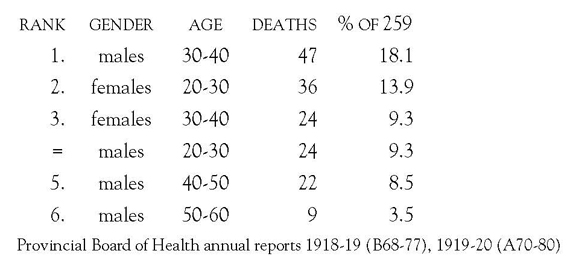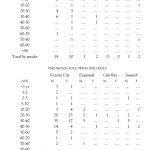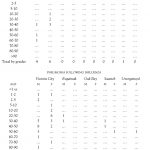The Spanish Flu flourished in densely populated areas. In India it is believed to have killed twelve million people. Across the United States, in cities and on military bases, it was catastrophic. The virus killed more than 14,000 people in Philadelphia in the first four-and-a-half months of the epidemic. On October 16, 1918, more than seven hundred Philadephians died. They died of the flu at the rate of twenty-five a year out of every one thousand residents.
In Greater Victoria, the total number of deaths recorded by the Provincial Board of Health and published in its annual reports was 259.
 Those numbers may be low. Some deaths from Spanish Flu and its complications may have been mis-identified, especially early in the epidemic.
Those numbers may be low. Some deaths from Spanish Flu and its complications may have been mis-identified, especially early in the epidemic.
From the numbers for 1918-19 and local population figures, the Provincial Health Officer came to the conclusion that about one per cent. of the province died from influenza that year. “While this may appear high,” wrote Dr. Young, “yet in comparison with other countries we were among the fortunate ones.”
Provincial Board of Health Annual Report, 1918-1919, p. B6.
A fact-check using figures in the vital statistics section of Dr. Young’s report for 1918-19 yields a mortality percentage about one-quarter lower than his.
The B.C. population was estimated to be 440,187, and “Indians (aborigines)” numbered 24,744, giving a total population at mid-1919 of 464,931. (p. B41) For comparison, the 1911 census showed the province’s population was 392,480 and the 1921 census, 524,582.
From BC Stats.
To calculate how many people died of Spanish influenza in B.C., the statistician combined the reported numbers of deaths from “influenza” and ”pneumonia following influenza” to reach a total of 2,733 deaths (B43), to which must be added 671 deaths of First Nations people from those two causes (B67), for a total 3,404 deaths attributable to Spanish influenza in the year.
The number of deaths (3,404) amounts to 0.732 per cent. of the total B.C. population of 464,931. In standard terminology, the death rate from Spanish Flu in B.C. in 1918-19 was 7.32 deaths per 1,000 per annum.
Maybe Dr. Young rounded a difficult number up to a simple 1 per cent.
Other conclusions reached by the Provincial Health Officer:
• Nearly a third (30 per cent.) of the population got the disease.
• “The death-rate in the localities that placed the ban on [meetings] immediately, and enforced it, is very much below the death rate of those points that were dilatory in adopting these measures.
• “A great deal of investigation has been carried on in regard to vaccines, and the consensus of opinion is that we do not know the exciting cause of the influenza and have not been able to isolate the germ; there is no vaccine against influenza. There is, however, a vaccine against its complications which is of value.”
• The wearing of face masks was not enforced.
The deputy registrar of vital statistics, Munroe Miller, who reported to Dr. Young, made these analyses:
• Total deaths registered 1918-19 = 6,696. (Not including Indians. Indian deaths = 1,046, so the total, total deaths were 7,742.) Total 1917, not including Indians = 3,896. Increase of 1918-19 total over 1917 total = 73.06 per cent. (B43)
• “[T]o show the full force of the epidemic … if we add ‘influenza’ and ‘pneumonia following influenza,’ not including Indians, we have a total of 2,733 out of 6,696, or 40.81 per cent. If from 6,696 we deduct 2,733 we have a remainder of 3,963, or, as nearly as possible, our normal death-roll.” (B44)
• Overall mortality in British Columbia for the reporting year July 1918-June 1919, was 14.78 deaths per 1,000 people. The 73 per cent. increase was, the deputy registrar wrote, “entirely due to the influenza.” It represents “a slight increase in the deaths from infectious diseases, but not such, with our population, as to warrant any apprehension.”
Population estimates in British Columbia in these years were just that — estimates. The deputy registrar of vital statistics pointed up the state of affairs:
It has become more than ever necessary to ascertain, as nearly as possible, numerically, what our population really is in order that the rates per thousand of births, deaths and marriages may be clearly shown. With that object in view, a census not having been taken for eight years, after conferring with different heads of departments, the conclusion has been arrived at that no better course can be found than that followed heretofore by this branch of the Service—viz., to depend on the enrollment of children in our public schools; consequently their number will be made the base on which we found our calculations to fix the number of our population.
The deputy registrar fixed on two multipliers: 6.5 for centres of industry and transportation nexes, 5.5 for agricultural areas.
Applying those multipliers to the numbers of registered schoolchildren in the four municipalities then comprising Greater Victoria yields an estimated population at mid-1919 of 56,109.
Dividing 259 deaths in two years by 59,109 total population yields a rough Spanish Flu mortality rate for Greater Victoria of 2.3 deaths per thousand per annum.
Compare Victoria’s fortunes with the estimated death rates in other cities. There is are two big caveats: using such soft numbers; and comparing apples and oranges (if, for example, reporting periods or methods of collecting data are different).
The stark truth remains that nearly three times as many people died of Spanish Flu in one awful day in Philadelphia than died in Greater Victoria in eighteen months.
British Columbia First Nations had an experience of Spanish Flu that exceeded Philadelphia’s. Its 1919 population estimated at just 24,744, B.C. First Nations suffered 671 deaths province-wide from Spanish Flu in 1918-19. That works out to 27.1 deaths per 1,000 people per annum. It was magnitudes higher than the death rate of the general B.C. population.
The deputy registrar of vital statistics reports for the two years 1918-19 and 1919-20 breaks down the mortality totals for each jurisdiction by age (14 groupings, most by decade), by gender and by cause of death. In the City of Victoria the highest mortality groups by reported numbers of deaths due to influenza or pneumonia following influenza over the two reporting periods were:
 These data show that one-half of Victorians who died from the Spanish Flu were between the ages of 20 and 40, a fact confirmed in many studies elsewhere. There’s a suggestion too that more men died than women.
These data show that one-half of Victorians who died from the Spanish Flu were between the ages of 20 and 40, a fact confirmed in many studies elsewhere. There’s a suggestion too that more men died than women.
Department of Vital Statistics’ compilations by year, cause of death, age, gender and jurisdiction:
1918-1919
1919-1920



